Foto Friday: Uptown Bike Corridor - A Look at the Changes Proposed
The SANDAG Uptown Project consists of three corridors and 12 miles of bike infrastructure that connects the neighborhoods of Bankers Hill, Hillcrest, Mission Hills, and Five Points to Old Town, Mission Valley, North Park, University Heights, Balboa Park and Downtown. The focus is to making bicycling an option for "everyday people" for "everyday trips" by converting streets that induce "high stress" to "low stress" streets.
At the most recent outreach meeting held in February, the analysis and results were presented to Uptown residents, business owners and stakeholders. Below are very promising design concepts that were presented.
Today University Avenue and most of Uptown's streets is designed solely for moving automobile traffic which has led to many road deaths that are stressful to walk alongside, ride on, and even drive.
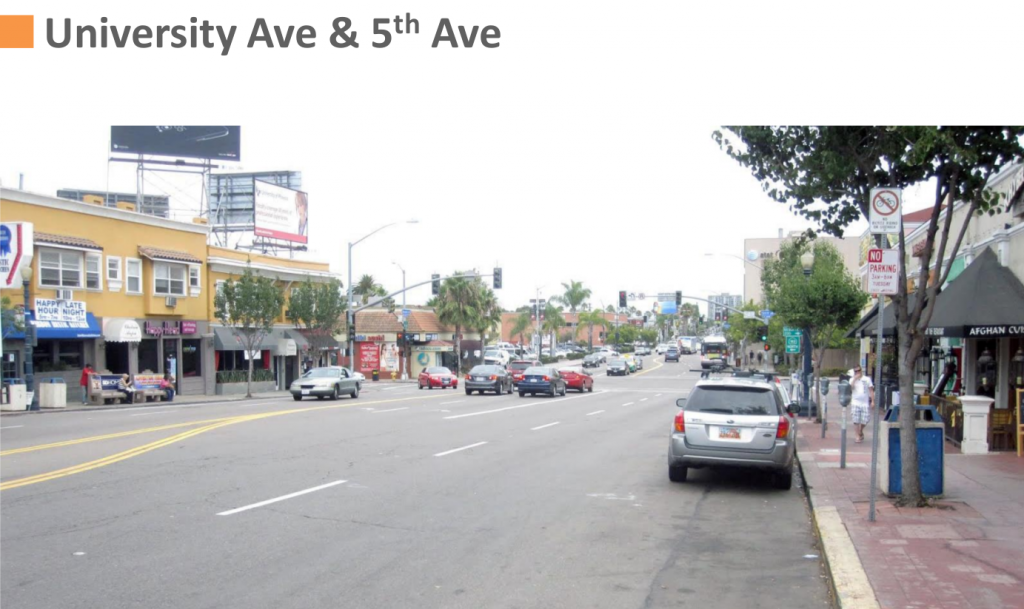
But the future looks bright for University Avenue
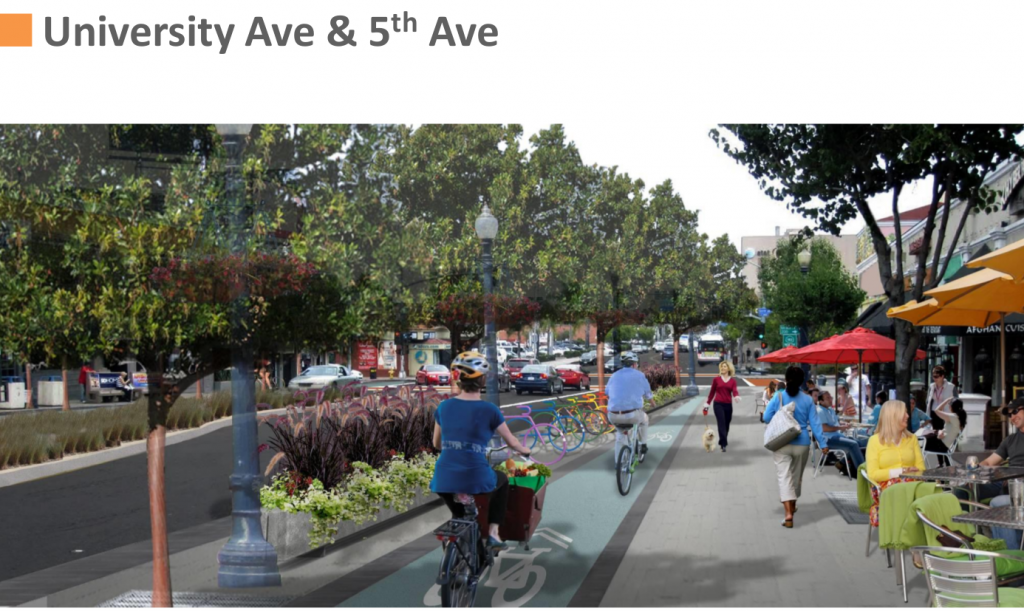
Today, University Avenue at 3rd is in a sorry condition. The best offering are some shared lane markings or sharrows along on University Avenue.
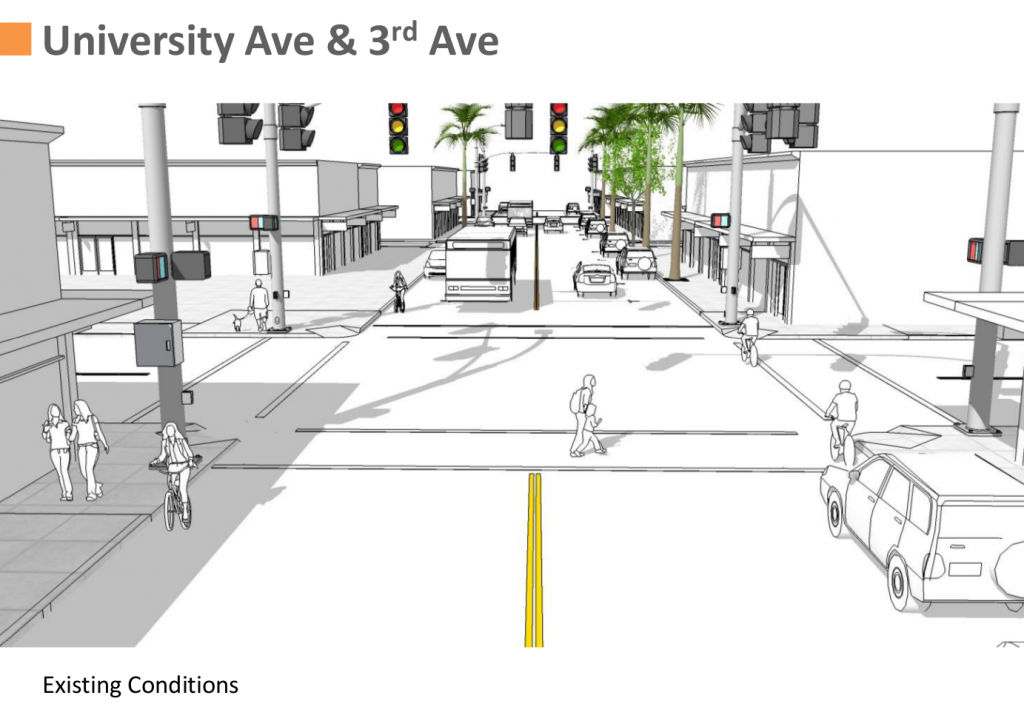
But the future looks very bright for University Avenue at 3rd with a proper protected bike lane/cycletrack.

One of the north/south alignments is 5th Avenue. Last month the city's first road diets were implemented to much fanfare and publicity.
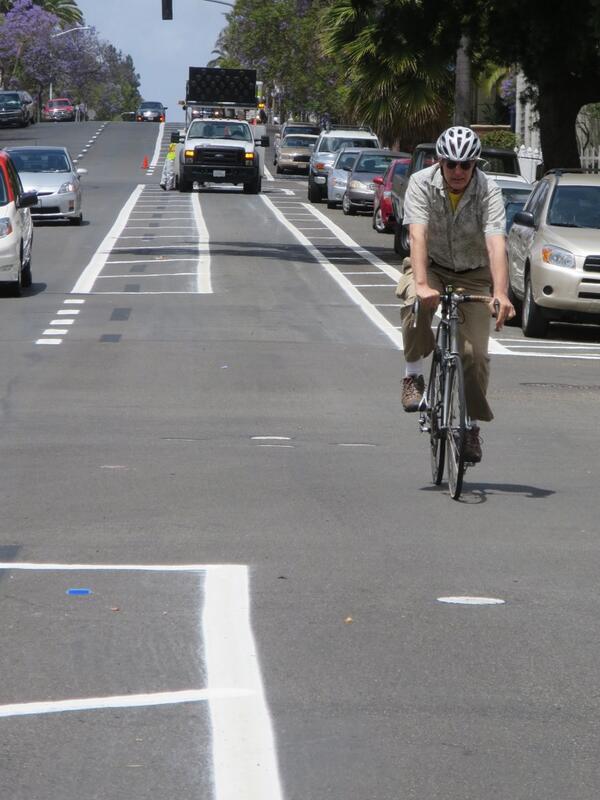
The future of 5th Avenue looks even better with, you guessed it, cycletracks:
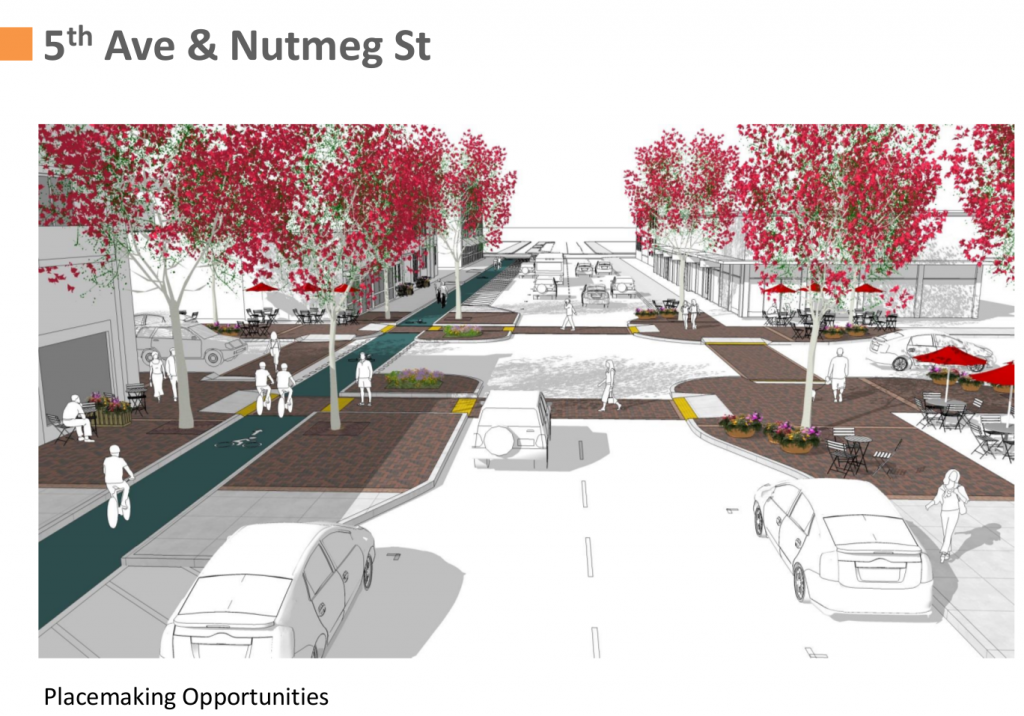
One of our readers, Bonnie Kucera, sent in this video of great intersection design that fits right into what we've been advocating all this time.
The future does indeed look bright. Don't you wish it would get here quickly?
What questions should the Uptown community leaders be asking?
The Early Action Bike Projects, of which both the Uptown Bike Corridor and the Mid-City Bike Corridor are a part of, are funded by the half-cent sales tax measure, Transnet, that is managed by our regional planning agency, SANDAG. Transnet dollars represent one of the largest pools of funds in the county, and is not unlike other half-cent sales tax measures that have been passed around the state largely to fund transportation projects. The extension for Transnet barely passed voter approval in the 2004 elections.
Transnet, to most of us in the transportation advocacy world, represents a net good because it are seen as a dedicated funding stream that will make San Diego more walkable, bikeable, and thus livable.
However in 2004, despite a fairly diverse coalition supporting the extension of Transnet - it barely passed voter approval at 67% (1% point more than was needed for support as this was a tax increase). The language of the extension touted solutions for traffic congestion, and yet the Environmental Health Coalition and Sierra Club registered their opposition to the ordinance. The EHC detailed their opposition stating (among other things):
Transnet Cheats Urban Neighborhoods!
"Almost 85% of all transit infrastructure funded by Transnet will serve suburban neighborhoods."
So when reviewing how voters around the city voted on Transnet's extension, it is hard to gauge what they wanted - did they vote "Yes" because they wanted "traffic congestion" eased? If so, did they want wider roads, more freeways and a more car-dependent society? Or did they vote "Yes" because they wanted more transportation options like safer bike infrastructure, wide sidewalks and a robust and well connected transit network? Did they vote "No" because they didn't want funds from the urban neighborhoods to fund suburban (and the more car-dependent) neighborhoods in the region? Or did they vote "No" because they are opposed to tax increases?
It's hard to say.
The Early Action Bike Projects are part of SANDAG's 2050 Regional Transportation Plan(RTP), which after approval by the SANDAG board in October 2011 (despite healthy opposition to the plan) was subsequently the subject of a lawsuit. As written here previously, the RTP was eventually "found to be illegal by the San Diego County Superior Court. The court found that the plan did not comply with California clean air laws. Whether the plan will need to be totally redone remains to be seen." That decision is now being appealed by SANDAG instead of simply re-doing their RTP and incorporating the suggestions they've captured in their most recent RTP Update process. BikeSD is on the record with the SANDAG Transportation Committee asking for the agency to not appeal.

Of the $200 billion, SANDAG has set aside $2.5 billion for bicycle and pedestrian projects (not as impressive when you think about the fact that it is 1.25% of the total funds). Of that $2.5 billion, $200 million was approved last fall by the SANDAG board to implement the RTP's early action bike projects.
The Uptown Bike Corridor is scheduled to receive an investment of $43.4 million of those Transnet funds where the east/west corridor of University Avenue is the subject of much contention as it may (again, may) affect the removal of 91 parking meters (10% of total parking spots available in Uptown within a block of University Avenue). These parking meters currently bring in about $40,000 to Uptown annually according to San Diego's Uptown Community Parking District's Chief Operating Officer, Elizabeth Hannon.
Just so you didn't miss those numbers: the numbers we're talking about is the current revenue brought in of approximately $40,000 versus an investment of $43.4 million into Uptown to expand the number of transportation choices of Uptown's residents and visitors.
Meanwhile, while some Uptown community leaders bicker over whether it is worthwhile to accept a $43.4 million investment over the remote possibility that they may lose $40,000, SANDAG bureaucrats continue to take tax money collected from the urban neighborhoods in San Diego; allocating it on projects in suburban, car-dependent neighborhoods where parking is plentiful and driving is not as stressful. In other words, an urban community fighting over providing vehicle parking is nothing short of a race to the bottom and a race they are destined to lose. The suburban communities will always win the parking issue with their free and plentiful parking.
What should the Uptown community leaders instead be asking? They should be asking for an accounting of total Transnet revenue collected in Uptown and exactly how much of those dollars are being re-invested in Uptown. In Fiscal Year 2012, the city of San Diego generated over $26 million in Transnet funds. How much of that $26 million was generated in Uptown and how much was reinvested back in Uptown? That is the question that needs answers.
Uptown Business Owner, Uptown Planning Board Member: Extremely Important for Uptown to be Accessible to Bicycle Riders
Tonight, please attend the Uptown Bike Corridor meeting to speak up in support for cycle tracks/protected bike lanes on University Avenue, Fourth and Fifth Avenues.
Details are below:
February 6, 2014
6 - 8:30 p.m.
Roosevelt Middle School Library
3366 Park Blvd
San Diego, 92103
Flier

Jennifer Totah who owns Jake’s on 6th Wine Bar is a strong supporter of our advocacy in Uptown. Jake’s on 6th Wine Bar is located on 6th Avenue in the heart of Hillcrest. Totah was one of the business owners who completed our survey so that we could understand what San Diego's business owners were concerned with and how we could best garner the business community's support in implementing our mission to advocate for world-class bike infrastructure in the city.
Totah stated she was "absolutely" willing to "replace [vehicle] curbside parking in front of [her] business for vehicle parking access 1-3 blocks away" . She added that it was "extremely important to be considered a bicycle friendly business".
After tonight's meeting, lets patronize Jake's in Uptown to show our support for a business that is demonstrating their willingness to be a leader in the Uptown business community.
Jennifer Totah sent in an email reiterating her business' support for bike infrastructure in Uptown.
Jake's on 6th Wine Bar supports expansion of bicycle infrastructure as a critical economic development strategy for our business and Hillcrest. The investments other cities in California and the San Diego region communities that have invested in this infrastructure have seen incredible benefits. Businesses have increased retail sales, enhanced the attractiveness of their neighborhoods, and become destinations for the young professional. That is the key to our future.
This plan is a down payment on the future economic development of our region. Jake's is committed to enhancing the quality of life and economic prosperity of Hillcrest and now is the time to embrace this vision.

Uptown Planners aren't all opposed to implementing world-class bicycle facilities in Uptown. Christopher Ward, who sits on the Uptown Planners board was also strong in his support for increasing transportation options. In an email he stated,
Uptown is an urban neighborhood with the opportunity to maintain its status as one of America's best neighborhoods if we can evolve to meet the transportation interests of residents and visitors alike. Or in going through our community plan update, we can ignore that opportunity. People of all age groups want to choose safe and efficient bicycle, pedestrian, and multi-modal opportunities to get to downtown, North Park, travel within Uptown or access the regional bike network. Study after study shows that improving bikabilty and walkability improves interest in, and sales at, small businesses along our main streets. As an Uptown Planners board member, I support efforts to make bicycling safe and comfortable for all users.
Uptown Bike Corridor: A Critical Juncture for Our City's Future
If you are a business owner that supports our mission and wants to see our city become a world class city for bicycling, please help us by taking this survey. It will help us evaluate any concerns you have so that we can consider them in our advocacy. Thank you.
---
In my previous post for Bike SD, I described the Interim Height Ordinance in Uptown and its use by community planners to promote lower densities and increased parking. This time I’ll be talking about the SANDAG Uptown Bike Corridor Project that would create protected bike lanes (cycle tracks) for both local residents and bicycle commuters.
On Thursday, February 6th there’s a community update on the Uptown Bike Corridor at Roosevelt Middle School (3366 Park Blvd), and final routes will likely be presented based on prior feedback.
The meeting is also an opportunity for local businesses to give their input. Bike SD has created a Bike Friendly Business Survey to understand their concerns and goals regarding safe bike lanes in San Diego.
The Uptown Bike Corridor is part of SANDAG’s San Diego Regional Bike Plan, a “network of corridors enabling residents to bike safely on more direct and convenient routes between major regional destinations”. It’s part of the San Diego Regional Comprehensive Plan, which provides “a balanced regional transportation system that supports smart growth and a more sustainable region.” Our elected leaders on SANDAG’s board unanimously support the Bike Plan, and directed over $200 million in Early Action funds to the project last year.
My last post suggested that the Uptown Planners Community Planning Group, who advises the city regarding land use and development projects, is out of touch with (or actively opposed to) current urban neighborhood trends. Its position on the Uptown Bike Corridor is no exception. During a meeting last year, a majority of the packed room spoke in support of cycle tracks on University (or Washington) Avenue, and 4th/5th Avenues. Uptown Planners responded by voting not to consider the project until the completion of its community plan in late 2015. Meanwhile construction of the Corridor is set to begin in 2016.
Funding doesn’t guarantee the Uptown Bike Corridor will be built. It faces strong opposition from Uptown Planners and some residents. At last year’s meeting, an Uptown board member said, “This is San Diego. We drive here. If you want to ride a bike, go to New York City.” While a majority of the board’s members likely make all their trips by car, this is not the trend among Americans between the ages of 16 and 35. For them, car travel is down by 23% while bicycle trips are up by 24%.
A report by the U.S. Public Interest Research Group states “(Younger Americans) are more likely to consider forms of transportation beyond the car – the go-to option for many older Americans”. Another report says millennials are “less likely to personally own a car or drive one regularly”, and “(cite the) environment as a motivation behind their transportation choices/routines”. This last reason is consistent with the sustainability part of the SANDAG Regional Comprehensive Plan. Conversely, here’s the view of an Uptown activist opposed to moving forward:
Uptown Activist, "Addressing climate change and minimizing automobile reliance...Hillcrest is(n't) the best place for that focus."
— Great Streets SD (@GreatStreetsSD) January 6, 2014
San Diego is losing millennials at a rate higher than nearly any other major U.S. city. Even the “hip” Hillcrest zip code of 92103 saw a two percent drop in persons aged 20-44 from 2000 to 2010. Could one reason be that our city has lagged its peers in implementing robust public transit and cycling infrastructure? The top cities millennials are moving to include Portland, Seattle, San Francisco, Denver, Minneapolis, D.C., and Austin, which are all on this list of “best cycling cities in America”. It’s urgent that San Diego and its current hourglass economy comprised of few middle-income workers attract a talented pool of younger residents to work in the highly-skilled industries driving our city’s economy. If the San Diego Regional Economic Development Corporation really wants to compete in the global market place and remain relevant in the coming months and years, the leadership at the EDC needs to start taking a serious look at our woefully inadequate bicycle infrastructure. Our talent is flocking to other cities and we're losing out.
Safe bike infrastructure isn’t just about millennials’ preferences - bicyclists of all ages are rightfully scared to venture onto our unsafe roads. Those opposed to safe bike lanes claim there aren’t enough riders to justify building them, yet the Green Lane Project describes 8 cases around the U.S. where installing protected bike lanes increased ridership from 54% to 266%. Last year’s CicloSDias event in San Diego saw thousands of riders take part, many of them families enjoying streets closed to auto traffic.
Opposition isn’t limited to Uptown Planners. The publisher of the Presidio Sentinel in Mission Hills has personally lobbied SANDAG against the Bike Corridor, and looks upon cycling as a lifestyle choice:
Just because we build a bike corridor, that doesn’t mean people will ride bikes. It’s about lifestyle. You choose to be a bicyclist.
Was teenager Angel Bojorquez, an Albertsons cashier working past the end of daily bus service, choosing to be a bicyclist when he was killed in a hit-and-run while riding a dangerous Rancho Santa Fe road?
It’s difficult to break the prevailing mindset in Southern California that roads are for cars only. A recent LA Times editorial stated:
The very design of the city has supported and emphasized the idea that the roads belong to them and that anybody not using a car is an interloper at best and a threat (to their rights, freedom of movement, even happiness) at worst. This familiar attitude suggests that every change to the city, whether it's new architecture or new transit lines, should be weighed primarily, if not exclusively, by its impact on motorists and levels of car traffic. It has seeped so deeply into the civic consciousness that it has fundamentally skewed debate on a wide range of crucial issues.
Drivers only pay 51% of road costs, and most cyclists and pedestrians are drivers too. Don’t they also deserve safe access to our roads?
Increased auto congestion is another justification against bike lanes, but isn’t this an inevitable by-product of vibrant, successful cities? The Uptown Bike Corridor will implement bike lanes on just a handful of the dozens of lanes devoted exclusively to parking and vehicle travel in Uptown.
Loss of street parking is the most common objection to the project. Yet on Park Boulevard, there will be a net gain of parking spaces for the Mid-City Rapid Bus Line by implementing angled parking on side streets. Can’t we do the same for the Bike Corridor? Increased meter rates/hours would also result in more parking turnover. And Hillcrest has implemented a business corridor shuttle with service to the free DMV parking lot.
Removing parking spaces or travel lanes for protected bike lanes has actually increased local business in several cases, including New York City, Fort Worth, Memphis, Long Beach, and Seattle (Uptown Planners ignored these examples when cited last year). In 2010, El Indio owner and Uptown Planner Jennifer Pesqueira vowed not to give up a single street parking space for the benefit of cyclist safety. It’s hard to find compromise with that.
Bike share is coming to San Diego in the next few months, adding hundreds to thousands of cycling trips per day to our roads. Are we going to put these riders, many of them visitors unfamiliar with our city, on unsafe streets forever?
Pedestrians benefit from bike lanes too, through road calming, removal of cyclists from sidewalks, and creation of pedestrian islands that shorten street crossing distances even more than bulb-outs used elsewhere in Uptown:
The obstacles bicyclists face in securing safe bike lanes for Uptown aren’t unique to San Diego. In Chicago, a woman summed up opposition to a proposed protected bike lane when she said, “I like the neighborhood the way it is". It isn’t just that improving safety for Chicago cyclists might inconvenience her, but because it requires change. And to many in Uptown, that’s simply unacceptable.
The truth is that neighborhoods do change over time, for better or worse. Uptown’s planners have placed residents’ parochial concerns over consensus-based regional transportation solutions, and they continue to apply yesterday’s auto-centric planning to the community’s future. If you want to change Uptown for the better, voice your support for safe bike lanes next Thursday.
Height Restrictions and Bicycles: Uptown is at a Transportation Crossroads
What is the Interim Height Ordinance, and what does it have to do with bicycles?
Currently, the Interim Height Ordinance (IHO) limits building heights in Hillcrest and Mission Hills to 65 and 50 feet, respectively. Prior to the IHO, the 1998 Uptown Community Plan allowed building heights up to 200 feet on some streets, and under these guidelines a 12-story hotel was proposed for 301 University Avenue in 2008. The project was out of scale for the relatively narrow street, so residents protested, and the City Council enacted the IHO for the two years required to complete Uptown’s Community Plan.
That was then. Now, over five years later, the Community Plan is targeted for completion in late 2015. Meanwhile the IHO has been extended repeatedly. Many residents and community leaders advocate for making it permanent, or even further reducing its height limit.
Why should Bike SD’s readers care about Uptown building heights? Because the Uptown Planners (the community planning group for Hillcrest, Bankers Hill, Mission Hills and University Heights) advises the city on both this issue and the proposed SANDAG Uptown Bike Corridor. Many of the board and community members who oppose smart growth in Uptown also oppose implementing safe bike lanes. Last year, Uptown Planners voted against even considering bike corridor implementation in their neighborhoods until the community plan was completed. In my next post, I’ll discuss the bike corridor in greater detail, and whether increased density can make neighborhoods more bike-friendly.
Since the IHO went into effect, the trend of millennials and empty-nesters moving to urban neighborhoods from suburbs has increased. Good resources on the subject include recent books The End of the Suburbs, Walkable City, and The Great Inversion and the Future of the American City. These new residents seek walkable, bikeable, active communities with various transit options to nearby downtown jobs. “Smart growth” and “transit-oriented development” are two terms describing the mixed-use construction built to accommodate them. There are numerous benefits to this trend, from reduced vehicle miles driven to increased public transit use, even increased innovation and reduced obesity rates. In San Diego, with projections of a large population increase in Council District 3, Hillcrest represents an ideal location for smart growth - without putting all new growth downtown, as some suggest.
Instead of addressing this demand, the IHO has arguably suppressed residential construction in Hillcrest. IHO supporters cited the Snooze AM building on 5th Avenue as an example of IHO-era construction, but it contains zero residential units. While there are many excellent examples of urban neighborhoods with human-scale architectures of 5 stories, commercial thoroughfares like eastern University Avenue, Park Boulevard, and 4th/5th/6th Avenues all present opportunities to carefully exceed this height without ruining the neighborhood’s character. To be fair, construction costs do increase significantly above 65 feet, and raising the height limit won’t magically produce affordable and middle class housing - but it would likely offer an improvement over the current lack of construction.
What are some reasonable alternatives to making the IHO permanent that permit mixed-use projects on main streets while retaining neighborhood character? One plan floated by city planning staff set 45-65 foot height limits for Mission Hills and Hillcrest, with discretionary review required above that level. Heights could surpass 100 feet if community amenities were provided, such as parks or plazas. Another plan offered by Walt Chambers on his Great Streets San Diego site considers commercial street widths. At a recent Uptown Planners meeting where Chambers’ plan was presented, the Uptown Community Planning Group Chair, Leo Wilson, acknowledged that height/discretionary limits between 65 and 100 feet might be a workable compromise.
Unfortunately, many community members are unwilling to budge from the IHO. Chief among their complaints are: congestion and lack of parking. However these problems are present in almost any urban neighborhood around the country.
Nearly all of San Diego was built for cars, often at the expense of pedestrians and bicycle riders. However I think Hillcrest is great precisely because it is different in this regard. The Hillcrest community owes its strengths of being more walkable with diverse amenities largely to its higher density (relative to the rest of the city). Furthermore, many potential new residents to Uptown have little desire to own a car and seek alternative transit options. So why do Uptown's leaders continue to insist on applying suburban planning principles to their community?
A diversity of incomes in Uptown could reduce congestion, since some lower-income workers would live near their jobs rather than driving in and parking. Instead, Hillcrest’s anti-growth stance is morphing it into a neighborhood that is exclusive only to individuals who occupy a higher income bracket. This is troubling, since the Uptown neighborhood used to welcome anyone - especially gays and lesbians who experienced discrimination. Now many of these same community members who used to be discriminated against are unwittingly discriminating against middle and lower-income earners, as they close the door to new residents due to their shortsighted stance on height limits and downzoning.
IHO proponents frequently state that the “good businesses will survive” without new growth, but doesn’t this aversion to increasing the height limit limit the total number of good businesses? Instead of a virtuous urban cycle of more residents attracting more businesses attracting more residents that we’ve witnessed in North Park and Little Italy, Hillcrest’s businesses struggle and the neighborhood’s vibrancy wanes.
Some residents have described a fear that outside developers would tear down historic architecture, but as a member of Save our Heritage Organisation, I support strengthening the city’s historic preservation laws in order to prevent this.
Bicycle riders will benefit from awareness of the challenges they face in implementing bike infrastructure in Uptown. The majority of the Uptown Planners’ board members, and the residents who attend its meetings, have demonstrated that they are either woefully out of touch or simply opposed to the interests of tomorrow’s Uptown residents. It’s important that we all participate in planning Uptown’s future, whether the issue is building heights or cycle tracks.
---
You can read more from Paul Jamason at SD Urban
